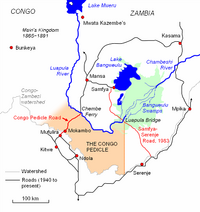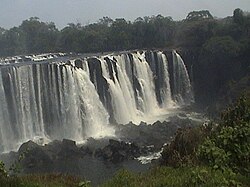Luapula Province
The province is bordered along the Luapula River, through Lake Mweru and to its north by DR Congo.Around 80.5 per cent of the population of Luapula is accounted as poor in 2010 census, making it the poorest of all provinces in Zambia.Major mineral deposits found in the province are manganese, lime, copper and precious metals.[3] The boundaries of the province between Zambia and DR Congo were disputed for many years, running from an 1894 treaty into the late 1960s.During the 1980s, the then President Kenneth Kaunda appointed traditional Chiefs of the region as District Governors or members of the powerful UNIP central committee.[4] Frederick Chiluba, the leader of Movement for Multi-Party Democracy (MMD), who went on to become the President of Zambia in 1991, obtained majority mandate during the 1991 elections.[5] The province is bordered along the Luapula River, through Lake Mweru and to its north by DR Congo.Major mineral deposits found in the province are manganese, lime, copper and precious metals.Sweet potato was the major crop in the province with 11,356 metric tonnes, constituting 7.56 per cent of the national output.There is a Deputy Permanent Secretary, heads of government departments and civil servants at the provincial level.[32] The administrative staff of the council is selected based on the Local Government Service Commission from within or outside the district.Councils are mandated to maintain each of their community centres, zoos, local parks, drainage system, playgrounds, cemeteries, caravan sites, libraries, museums and art galleries.They also work along with specific government departments to help in agriculture, conservation of natural resources, postal service, establishing and maintaining hospitals, schools and colleges.[35] Lusenga Plain National Park and Bangweulu Wetlands are the major wildlife areas in the province.The event involves enacting the migration of Luba Lunda and conquest of the valley by the chiefs of the tribe during historic times.

ProvinceCountryZambiaTime zoneprovincesLuapula River2022 Zambian censusDemocratic Republic of the CongoLake BangweuluLake MweruLumangwe FallsMumbuluma FallsSamfyaMwansabombweNchelengeKingdom of LundaKazembedisputedUnited National Independence PartyPresidentKenneth KaundaFrederick ChilubaMovement for Multi-Party Democracy1991 electionsagricultural subsidiesCongo PedicleCopperbeltSerenjeChembe BridgeMansa districtsalientKatanga ProvinceNorthern ProvinceCentral Provincemanganesecopperprecipitation2010 Zambian census2000 Zambian censusunemployment ratetotal fertility rateAlbinisminfant mortality rateInternational Monetary FundMalariadistrictsChembe DistrictChiengi DistrictChifunabuli DistrictChipili DistrictKawambwa DistrictLunga DistrictMilenge DistrictMwansabombwe DistrictMwense DistrictNchelenge DistrictSamfya DistrictMporokoso DistrictNtumbacushi FallsKalungwishi RiverChienge DistrictLusenga Plain National ParkBangweulu WetlandsLuba LundaDistricts of ZambiaChibomboChisambaChitamboKapiri MposhiMkushiMumbwaNgabweShibuyunjiCopperbelt ProvinceChililabombweChingolaKalulushiLuanshyaLufwanyamaMasaitiMpongweMufuliraEastern ProvinceChadizaChasefuChipangaliChipataKasenengwaKateteLumeziLundaziLusangaziMambweNyimbaPetaukeChembeChiengiChifunabuliChipiliKawambwaMilengeMwenseLusaka ProvinceChilangaChongweLuangwaLusakaRufunsaMuchinga ProvinceChinsaliKanchibiyaLavushimandaMafingaNakondeShiwa Ng'anduChilubiKaputaKasamaLupososhiLuwinguMporokosoMpulunguMungwiNorth-Western ProvinceChavumaIkelenge